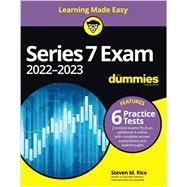The study tool you need for the Series 7 Exam
Your gateway to the world of finance is the Series 7 Exam: pass it and you’re in for a rewarding career as a stockbroker. You don’t have to study for this important exam alone—Series 7 Exam For Dummies gives you all the tips, tricks, and practice you need to obtain your required certification.
This book smartly balances three areas of study in one convenient package: the topics on the exam, how to prepare for test day and to take the exam, and practice tests. Find in this book:
- How to sign up for the test, and tips to get through test day
- Different study strategies
- The basics of security investments, such as equity securities and municipal bonds
- More advanced security topics, such as margin accounts and packaged securities
- How to conduct market research, such as portfolio and securities analysis
- Legal concerns: IRS, rules, and regulations
- Chapter exams and online practice quizzes
With Series 7 Exam For Dummies as your study guide, you’ll be ready to tackle the 125 exam questions. Whether it’s a question about the underwriting process, investment companies, or income-tax implications, you’ll find all the information to prepare in this resourceful book.
Your stockbroker career is just one certification away—get your copy of Series 7 Exam For Dummies (with included online practice tests) to get started on your career you’ve worked hard for.









